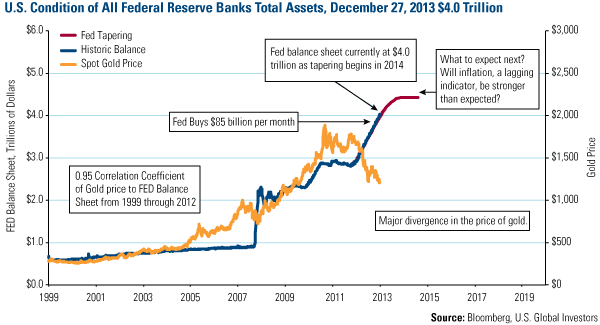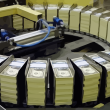Gold Market Radar (December 30, 2013)
For the week, spot gold closed at $1,212.93, up $9.63 per ounce, or 0.80 percent. Gold stocks, as measured by the NYSE Arca Gold Miners Index, rose 4.21 percent. The U.S. Trade-Weighted Dollar Index lost 0.27 percent for the week.
Strengths
- Platinum futures jumped the most in 10 weeks on speculation that a global economic rebound will boost demand for the metal used for pollution control devices in cars. Platinum reached a two-week high on Friday in the most active trading of the session. A recent Bloomberg survey shows the price of the precious metal is expected to rally to $1,650 an ounce in 2014 as consumption surpasses output. Demand exceeded supply this year by the most since 1999 and the continuation of the synchronized global economic recovery will likely lead to an even greater shortage in 2014.
- India's Commerce Ministry has asked to ease the restrictions on the import of gold, imposed by the Reserve Bank of India (RBI), in an effort to control the rising current account deficit. In a letter to Economic Affairs Secretary, Commerce Secretary S. R. Rao asked him to "look into the matter" and issue necessary instructions to the RBI for the removal of the anomaly. The move would relieve jewelers who have been reeling from the government induced gold import curbs. So far, the government has responded with a bid to relax some of the conditions currently imposed on the import of gold ore by refiners, with the aim of kick starting India's waning gold refineries, which have been operating at only 25 percent of installed capacity. Official sources have argued that the nation's current account deficit has compressed significantly since the introduction of the import curbs, and this can be read as a first step in reducing the import duty on gold in a calibrated manner.
- The German Bundesbank announced it has transferred 37 tons of gold back from New York and Paris to its Frankfurt vaults. Bundesbank President Jens Weidmann said the transfer was prompted by new a Bundesbank storage concept to hold gold in Frankfurt, and not because of concerns over its availability. However, Germany's Federal court concluded in 2011 that the nation's gold holdings overseas weren't regularly checked, which prompted the initiation of plans to bring back a total 700 tons previously in deposit with the Fed and the Banque de France. As a Zero Hedge article points out, procuring physical gold seems to be a rather problematic and time-consuming process, as the Bundesbank is learning. It was almost exactly one year ago in mid-January, when the German central bank, in a shocking development expressing the bank's lack of trust in its central banking peers, announced that it would proceed with the repatriation of 700 tons of gold held by its peers, only to learn it would take 7 years, or until 2020, to repatriate the full amount.
Weaknesses
- Gold is set to post its biggest annual loss in more than three decades as rallying U.S. equities and optimism about a synchronized global economic recovery lowered its safe haven appeal. The near 30 percent slump in 2013 ends a 12-year rally prompted by rock bottom interest rates and rapidly expanding central banks' balance sheets. The mood remains bearish among generalists who expect prices to drop further next year. Several brokerages such as Goldman Sachs, BNP Paribas and Societe General have gold price targets below $1,150 in 2014. Physical demand, which climbed to peak levels this year, has shown it can provide support on the downside, but it has failed to drive prices higher. Silver is down just under 35 percent for the year, its worst annual performance since at least 1981.
- Jaguar Mining Inc., the operator of two Brazilian gold mines, filed for bankruptcy protection in Canada as it tries to restructure its debt. Jaguar started proceedings under the Companies' Creditors Arrangement Act in Ontario, with the aim to reduce total pro forma debt via a recapitalization; reduce projected annual cash interest payments; and invest approximately $50 million of new equity raised through current holders of the company's convertible notes.
- On December 23rd, Detour Gold Corp. announced an unplanned mill shutdown. According to the announcement, the processing plant was shut down on December 17 due to mechanical issues with the pre-leach thickener system. Further inspection found structural damage to the torque cage. Management estimates that the processing plant will restart prior to year end. Credit Suisse analysts believe the unplanned shutdown will result in a fourth quarter gold production miss, which will roll over and cause the company to miss its already lowered full year 2013 production guidance of 240-260 thousand ounces. In addition, Credit Suisse warns to remain cautious around consistency of the mining rate to keep pace with the mill, grade reconciliation and recovery rates, and longer term, the economic viability of the low grade tail of reserves.
Opportunities
- The metals analysts at J.P. Morgan think it is easy to look at the cost of new mines and conclude that current prices are unsustainable. In addition, JPM analysts assert that on Wall Street the question of future inflation is a when, and not if, proposition. With central banks around the world still printing money at a furious pace, a debasement of the value of their currencies is forthcoming. As a result, the J.P. Morgan team thinks now is the time to look hard at gold and silver as hedges, especially given the golden opportunity created by the recent downturn in prices. The motivation is that contrarian investing has paid off big for patient investors, and it can pay off even bigger when the whole world is negative on the asset class, such as gold at present time. Just a few short years ago major homebuilders traded in the single digits, while banks and brokerage firms got clobbered in 2008. The recovery in those sectors has paid off handsomely. With gold, once inflation finally kicks in after years of currency printing, the patient gold investor may again have his day in the sun.
- Capital Economics argues the precious metal could come back into favor in 2014. “The consensus is that the price of gold will grind lower in 2014, at best, as the support from loose U.S. monetary policy gradually weakens," said Julian Jessop, head of commodities research at the firm. “In contrast, with investor sentiment already so heavily negative, our view is that the risks for the coming year are firmly skewed to the upside." According to Jessop, the latter half of 2013 suggests the worst of the slump may be over. Indeed, during this period, gold prices staged a partial recovery, rising to $1,400 before dropping back to current levels around $1,200. Jessop added that that next year, a re-emergence of eurozone instability, and the Fed's continued asset purchase program, could work to boost gold prices. Although the Fed has announced a small taper, it will still be pumping large amounts of stimulus into the economy through most, if not all, of 2014. “We are happy to reiterate our view that the price of gold will revisit $1,400, at least, in 2014, and probably go higher," Jessop concluded.
- Metal and crop prices are poised to rebound in 2014 as accelerating economic growth boosts demand, according to a Bloomberg story. Average annual prices for 15 of 23 non-energy commodities from aluminum to sugar will be higher than now, according to estimates from as many as 26 analysts compiled by Bloomberg. Corn, silver and gold dropped the most in 2013. “It's a good time to come into commodities," said James Paulsen, the Minneapolis-based chief investment strategist at Wells Capital Management, which oversees about $340 billion of assets. “This is the first time in the recovery that we've had simultaneous positive and accelerating growth in the U.S., Europe, Japan and the emerging world all at the same time. Economic growth may not be enough to end the slump. Silver, after posting the biggest loss of any precious metal, will rise as much as 28 percent in 2014 to $25 an ounce on spot markets, according to the median of 40 estimates. Gold will gain 20 percent to $1,450, based on 59 estimates. On the bearish side, Jeffrey Currie, Goldman's head of commodities research in New York said there will be “significant" declines through next year for iron ore, gold, soybeans and copper. He added that gold will slide to $1,110 an ounce in 12 months.
Threats
- Barrick Gold Corp. agreed to sell its Plutonic mine in Western Australia to Northern Star Resources for A$25 million as it tries to cut costs and focus on its most profitable operations. The total purchase consideration appears to be less than half of the lower range estimated by a Seeking Alpha contributor drawing from recent comparable transactions. According to the same report, the Plutonic mine has been in operation since 1990 and has yielded 5.24 million ounces in its mine life so far. The mine has consistently produced around 100,000 ounces per year and has a history of reliable resource to reserve conversion. Similarly, Rio Tinto Group, the world's second- largest mining company, is considering selling its stake in the massive Alaskan Pebble copper-gold project as it cuts costs across its businesses. In our view, these announcements continue to demonstrate the atrocious market timing performance of major producers who are only compelled to apply financial restraint and divest assets at rock bottom valuations, while increasing capital spending and acquisitions near market peaks, all to the detriment of shareholders.
- According to David Rosenberg of Gluskin Sheff, wage inflation is a key source of upside risks to growth in 2014, and that is not on the radar screen. The recent Beige Book had abundant anecdotal evidence highlighting job shortages on high-skill trades. Rosenberg estimates that out of the 115 million people currently employed in the private sector, roughly 40 million of them are going to be reaping the benefits of a higher stipend. With the Fed still consumed with deflation fears, and job firings already 20 percent below 2007 levels, Rosenberg argues that inflation is likely to surprise to the upside. In such an environment, gold is likely to regain strength on the basis of its hedging qualities. In addition, the areas of consumer spending that showed the greatest positive sensitivity to periods of rising wage growth include jewelry and electronics; sectors that may provide incremental demand for both gold and silver.
- A Financial Times article this week speaks to the crisis of confidence in the mining sector. According to the report, the number of new mining listings in Canada, where roughly 70 percent of all mining equity finance is raised, plunged fuelled by a steep decline in metal prices. Up until the end of November, 62 companies had listed on the Toronto Stock Exchange or the TSX venture exchange, compared with 129 by the same point in 2012 and more than 200 in both 2009 and 2010. The amount of equity raised in Toronto has also fallen from $10.3 billion in the whole of 2012 to just $6.5 billion by the end of November. Almost half of this year's total to date came in November when Barrick Gold, raised $3.1 billion of fresh equity.















